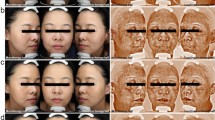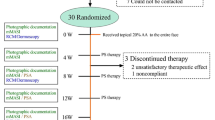Abstract
This split-face, double-blind, randomized controlled study examines the efficacy of fractional thulium laser (FTL)–assisted delivery of topical tranexamic acid (TXA) compared with FTL alone as a treatment option for melasma. Forty-six adults with Fitzpatrick skin types III–V and recalcitrant melasma underwent four weekly treatments with fractional 1927-nm thulium laser on both sides of the face. Immediately after treatment, TXA was applied to one side of the face and normal saline solution (NSS) to the contralateral side as control under occlusion. Melanin index (MI), modified MASI (mMASI), and patients’ self-assessed improvement scores were measured at baseline, 1 week, 4 weeks, and 3- and 6 months after the final treatment and were examined statistically with a paired sample t test with significance set at p ≤ 0.05. The majority of the participants (95.7%, n = 44) were female with Fitzpatrick skin type IV (82.6%) and a mean age of 48.0 ± 10.0 years. Twenty-nine individuals were able to be followed up until the 6-month assessment. Significant improvement from baseline was seen in both the MI and mMASI scores for both the TXA and control sides at 3 months, with no statistically significant difference between sides. By the 6th month, significant differences in MI and mMASI scores from baseline were still noted, except in the MI for controls. The patients’ self-assessment showed similar patterns. No serious adverse events were reported for either group. A regimen of FTL-assisted delivery of TXA over a 4-week period is a safe and effective treatment option for melasma, producing significant improvement up to 3 months. Results further would suggest a repeat regimen every 3 months could be useful for treatment of recalcitrant melasma.



Similar content being viewed by others
References
Kwon SH, Park KC (2014) Melasma and common pigmentary dermatoses in Asian individuals and an overview of their treatment. J Clin Investig Dermatol 2(1):8
Newcomer VD, Lindberg MC, Sternberg TH (1961) A melanosis of the face (“chloasma”). Arch Dermatol 83(2):284–299
Grimes PE (1995) Melasma: etiologic and therapeutic considerations. Arch Dermatol 131(12):1453–1457
Kim EH, Kim YC, Lee ES, Kang HY (2007) The vascular characteristics of melasma. J Dermatol Sci 46(2):111–116
Pathak MA, Riley FC, Fitzpatrick TB (1962) Melanogenesis in human skin following exposure to long-wave ultraviolet and visible light. J Invest Dermatol 39:435–443
Suggs AK, Hamill SS, Friedman PM (2018) Melasma: update on management. Semin Cutan Med Surg 37(4):217–225
Rivas S, Pandya AG (2013) Treatment of melasma with topical agents, peels and lasers: an evidence-based review. Am J Clin Dermatol 14(5):359–376
Sarkar R, Aurangabadkar S, Salim T, Das A et al (2017) Lasers in melasma: a review with consensus recommendations by Indian Pigmentary Expert Group. Indian J Dermatol 62(6):585–590
Kang H, Kim J, Goo B (2011) The dual toning technique for melasma treatment with the 1064 nm Nd: YAG laser: a preliminary study. Laser Ther 20(3):189–194
Kim JH, Kim H, Park HC, Kim IH (2010) Subcellular selective photothermolysis of melanosomes in adult zebrafish skin following 1064-nm Q-switched Nd:YAG laser irradiation. J Invest Dermatol 130(9):2333–2335
Mun JY, Jeong SY, Kim JH, Han SS, Kim IH (2011) A low fluence Q-switched Nd:YAG laser modifies the 3D structure of melanocyte and ultrastructure of melanosome by subcellular-selective photothermolysis. J Electron Microsc 60(1):11–18
Chan NP, Ho SG, Shek SY, Yeung CK, Chan HH (2010) A case series of facial depigmentation associated with low fluence Q-switched 1,064 nm Nd:YAG laser for skin rejuvenation and melasma. Lasers Surg Med 42(8):712–719
Wattanakrai P, Mornchan R, Eimpunth S (2010) Low-fluence Q-switched neodymium-doped yttrium aluminum garnet (1,064 nm) laser for the treatment of facial melasma in Asians. Dermatol Surg 36(1):76–87
Perper M, Eber AE, Fayne R, Verne SH, Magno RJ et al (2017) Tranexamic acid in the treatment of melasma: a review of the literature. Am J Clin Dermatol 18(3):373–381
Taraz M, Niknam S, Ehsani AH (2017) Tranexamic acid in treatment of melasma: a comprehensive review of clinical studies. Dermatol Ther 30(3). https://doi.org/10.1111/dth.12465
Kim HJ, Moon SH, Cho SH, Lee JD, Kim HS (2017) Efficacy and safety of tranexamic acid in melasma: a meta-analysis and systematic review. Acta Derm Venereol 97(7):776–781
Sheu SL (2018) Treatment of melasma using tranexamic acid: what’s known and what’s next. Cutis 101(2):E7–E8
Colferai MMT, Miquelin GM, Steiner D (2018) Evaluation of oral tranexamic acid in the treatment of melasma. J Cosmet Dermatol. https://doi.org/10.1111/jocd.12830
Zhu CY, Li Y, Sun QN, Takada A, Kawada A (2019) Analysis of the effect of different doses of oral tranexamic acid on melasma: a multicentre prospective study. Eur J Dermatol 29(1):55–58
Kim SJ, Park JY, Shibata T, Fujiwara R, Kang HY (2016) Efficacy and possible mechanisms of topical tranexamic acid in melasma. Clin Exp Dermatol. 41(5):480–485
Bagherani N, Smoller BR (2015) The efficacy of topical tranexamic acid in the treatment of melasma. Dermatol Ther 28(4):265
Atefi N, Dalvand B, Ghassemi M, Mehran G, Heydarian A (2017) Therapeutic effects of topical tranexamic acid in comparison with hydroquinone in treatment of women with melasma. Dermatol Ther (Heidelb) 7(3):417–424
Iraji F, Nasimi M, Asilian A, Faghihi G et al (2019) Efficacy of mesotherapy with tranexamic acid and ascorbic acid with and without glutathione in treatment of melasma: a split face comparative trial. J Cosmet Dermatol. https://doi.org/10.1111/jocd.12874
Xu Y, Ma R, Juliandri J, Wang X, Xu B et al (2017) Efficacy of functional microarray of microneedles combined with topical tranexamic acid for melasma: a randomized, self-controlled, split-face study. Medicine 96(19):e6897
Laothaworn V, Juntongjin P (2018) Topical 3% tranexamic acid enhances the efficacy of 1064-nm Q-switched neodymium-doped yttrium aluminum garnet laser in the treatment of melasma. J Cosmet Laser Ther 20(6):320–325
Cho SB, Goo BL, Zheng Z, Yoo KH et al (2018) Therapeutic efficacy and safety of a 1927-nm fractionated thulium laser on pattern hair loss: an evaluator-blinded, split-scalp study. Lasers Med Sci 33(4):851–859
Lee HM, Haw S, Kim JK, Chang SE, Lee MW (2013) Split-face study using a 1,927-nm thulium fiber fractional laser to treat photoaging and melasma in Asian skin. Dermatol Surg 39(6):879–888
Acknowledgments
The authors wish to thank Ms. Phassara Klamsawat, Ms. Phonsuk Yamlexnoi, and Mr. Panyawat Wongjaruwat for their assistance in recruiting subjects and managing the database. The authors acknowledge Lutronic Corporation, Goyang, South Korea, for loaning the laser system without charge and for providing the tranexamic acid ampoules used in the study.
Availability of data and material
All data and materials in this study support their published claims.
Funding
This research project is supported by Faculty of Medicine Siriraj Hospital, Mahidol University.
Author information
Authors and Affiliations
Contributions
RW and FS drafted and revised the manuscript; RW and PP wrote the protocol of the study and performed the procedures; TT, SE, and WM reviewed and corrected the manuscript.
Corresponding author
Ethics declarations
Conflict of interest
The authors declare that they have no conflict of interest.
Ethical approval
The study protocol was approved by the Ethics Committee of the Siriraj Institutional Review Board (SIRB) and in accordance with the ethical standards stated in the Belmont Report. All authors have reviewed and approved this version of the manuscript. All authors give their consent for this submission. All authors give their consent for publication.
Additional information
Publisher’s note
Springer Nature remains neutral with regard to jurisdictional claims in published maps and institutional affiliations.
Rights and permissions
About this article
Cite this article
Wanitphakdeedecha, R., Sy-Alvarado, F., Patthamalai, P. et al. The efficacy in treatment of facial melasma with thulium 1927-nm fractional laser-assisted topical tranexamic acid delivery: a split-face, double-blind, randomized controlled pilot study. Lasers Med Sci 35, 2015–2021 (2020). https://doi.org/10.1007/s10103-020-03045-8
Received:
Accepted:
Published:
Issue Date:
DOI: https://doi.org/10.1007/s10103-020-03045-8




